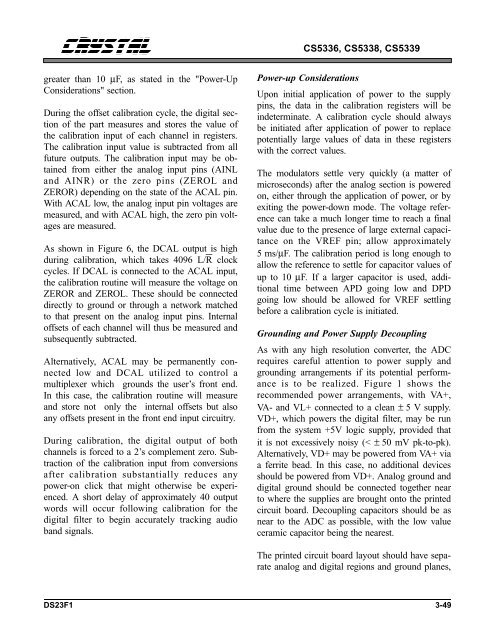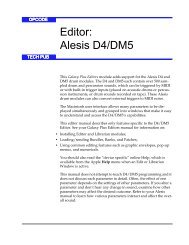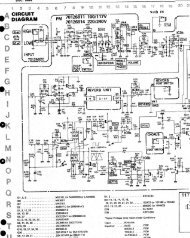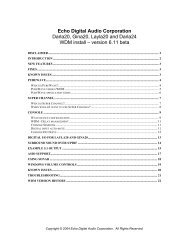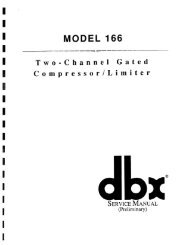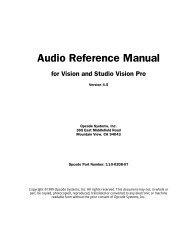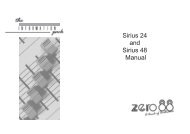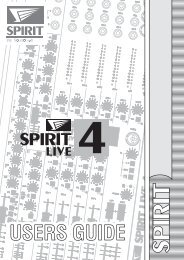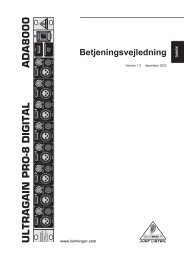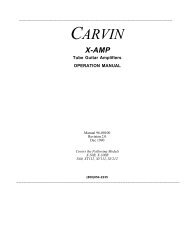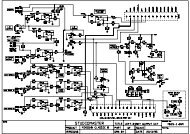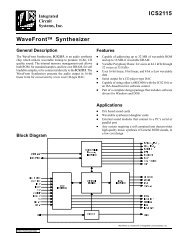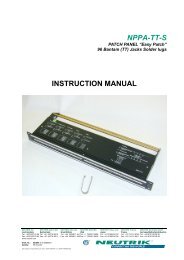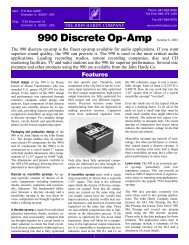Crystal - cs5336.pdf
Crystal - cs5336.pdf
Crystal - cs5336.pdf
Create successful ePaper yourself
Turn your PDF publications into a flip-book with our unique Google optimized e-Paper software.
CS5336, CS5338, CS5339<br />
greater than 10 µF, as stated in the "Power-Up<br />
Considerations" section.<br />
During the offset calibration cycle, the digital section<br />
of the part measures and stores the value of<br />
the calibration input of each channel in registers.<br />
The calibration input value is subtracted from all<br />
future outputs. The calibration input may be obtained<br />
from either the analog input pins (AINL<br />
and AINR) or the zero pins (ZEROL and<br />
ZEROR) depending on the state of the ACAL pin.<br />
With ACAL low, the analog input pin voltages are<br />
measured, and with ACAL high, the zero pin voltages<br />
are measured.<br />
As shown in Figure 6, the DCAL output is high<br />
during calibration, which takes 4096 L/R clock<br />
cycles. If DCAL is connected to the ACAL input,<br />
the calibration routine will measure the voltage on<br />
ZEROR and ZEROL. These should be connected<br />
directly to ground or through a network matched<br />
to that present on the analog input pins. Internal<br />
offsets of each channel will thus be measured and<br />
subsequently subtracted.<br />
Alternatively, ACAL may be permanently connected<br />
low and DCAL utilized to control a<br />
multiplexer which grounds the user’s front end.<br />
In this case, the calibration routine will measure<br />
and store not only the internal offsets but also<br />
any offsets present in the front end input circuitry.<br />
During calibration, the digital output of both<br />
channels is forced to a 2’s complement zero. Subtraction<br />
of the calibration input from conversions<br />
after calibration substantially reduces any<br />
power on click that might otherwise be experienced.<br />
A short delay of approximately 40 output<br />
words will occur following calibration for the<br />
digital filter to begin accurately tracking audio<br />
band signals.<br />
Power-up Considerations<br />
Upon initial application of power to the supply<br />
pins, the data in the calibration registers will be<br />
indeterminate. A calibration cycle should always<br />
be initiated after application of power to replace<br />
potentially large values of data in these registers<br />
with the correct values.<br />
The modulators settle very quickly (a matter of<br />
microseconds) after the analog section is powered<br />
on, either through the application of power, or by<br />
exiting the power-down mode. The voltage reference<br />
can take a much longer time to reach a final<br />
value due to the presence of large external capacitance<br />
on the VREF pin; allow approximately<br />
5 ms/µF. The calibration period is long enough to<br />
allow the reference to settle for capacitor values of<br />
up to 10 µF. If a larger capacitor is used, additional<br />
time between APD going low and DPD<br />
going low should be allowed for VREF settling<br />
before a calibration cycle is initiated.<br />
Grounding and Power Supply Decoupling<br />
As with any high resolution converter, the ADC<br />
requires careful attention to power supply and<br />
grounding arrangements if its potential performance<br />
is to be realized. Figure 1 shows the<br />
recommended power arrangements, with VA+,<br />
VA- and VL+ connected to a clean ± 5 V supply.<br />
VD+, which powers the digital filter, may be run<br />
from the system +5V logic supply, provided that<br />
it is not excessively noisy (< ± 50 mV pk-to-pk).<br />
Alternatively, VD+ may be powered from VA+ via<br />
a ferrite bead. In this case, no additional devices<br />
should be powered from VD+. Analog ground and<br />
digital ground should be connected together near<br />
to where the supplies are brought onto the printed<br />
circuit board. Decoupling capacitors should be as<br />
near to the ADC as possible, with the low value<br />
ceramic capacitor being the nearest.<br />
The printed circuit board layout should have separate<br />
analog and digital regions and ground planes,<br />
DS23F1 3-49


